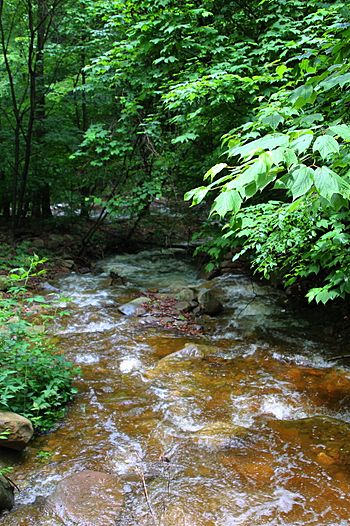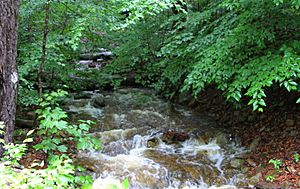Lead Run facts for kids
Quick facts for kids Lead Run |
|
|---|---|

Lead Run looking downstream
|
|
| Physical characteristics | |
| Main source | plateau in eastern Davidson Township, Sullivan County, Pennsylvania 2,260 to 2,280 feet (690 to 690 m) |
| River mouth | East Branch Fishing Creek in Davidson Township, Sullivan County, Pennsylvania 1,155 ft (352 m) |
| Length | 1.5 mi (2.4 km) |
| Basin features | |
| Progression | East Branch Fishing Creek → Fishing Creek → Susquehanna River → Chesapeake Bay |
| Basin size | 0.82 sq mi (2.1 km2) |
Lead Run is a small stream, or tributary, that flows into East Branch Fishing Creek in Sullivan County, Pennsylvania. It's about 1.5 miles (2.4 km) long and runs through Davidson Township. The area of land that drains into Lead Run, called its watershed, is about 0.82 square miles (2.1 km²).
The water in Lead Run has a low pH (meaning it's acidic) and isn't very clean. Scientists believe this could be fixed. The rocks around the stream are mainly the Catskill Formation, the Huntley Mountain Formation, and the Burgoon Sandstone. The soil types nearby include the Deep-Wellsboro-Oquaga, Norwich, and Oquaga associations.
Contents
Where Does Lead Run Flow?
Lead Run starts on a flat, high area called a plateau in eastern Davidson Township. It flows west-northwest for about 0.2 miles (0.3 km). Then, it turns southwest and goes into a deep, narrow valley called a ravine, where it stays for over a mile.
Close to where it ends, the stream leaves the ravine. It turns south and then east before joining East Branch Fishing Creek. Lead Run meets East Branch Fishing Creek about 4.12 miles (6.63 km) upstream from where that creek ends.
No Named Branches
Lead Run doesn't have any named smaller streams flowing into it. However, it does have several unnamed little branches that add water to it.
Understanding Lead Run's Water
The amount of water flowing in Lead Run, called its discharge, is usually about 821 gallons (3,108 liters) per minute. Sometimes, especially in summer, the stream can dry up completely for a while. The average pH of the water is 4.44, which is quite acidic. The water also has an average of 0.301 milligrams of aluminum per liter.
Lead Run's water is considered to have "severe" quality, which is even worse than "very poor." This stream also makes the water quality of East Branch Fishing Creek a bit worse, though it's not the main reason for the creek's acidity.
Improving Water Quality
Experts have suggested a method called "road liming" to make Lead Run's water less acidic. This involves adding a substance called lime to the area. The estimated cost to improve Lead Run and a nearby stream called Trout Run is about $120,000. This project is the seventh and final step in a plan to restore East Branch Fishing Creek.
About 1.84 miles (2.96 km) of streams in Lead Run's watershed are considered "impaired," meaning their water quality is not good. The main reasons for this impairment are air pollution (called atmospheric deposition) and metals in the water.
Land and Rocks Around the Stream
The land near where Lead Run joins East Branch Fishing Creek is about 1,155 feet (352 meters) above sea level. Where the stream begins, the elevation is higher, between 2,260 feet (689 meters) and 2,280 feet (695 meters).
The lower parts of Lead Run flow over rocks from the Catskill Formation. The middle part of the stream is on rocks from the Huntley Mountain Formation. The very beginning of the stream is on Burgoon Sandstone.
Most of the soil around Lead Run is part of the Deep-Wellsboro-Oquaga soil type. However, the higher areas of the watershed have Norwich and Oquaga soil types. Most of the soil in the watershed is very acidic. You can also see some rocks sticking out of the ground, called outcroppings, near the stream.
Lead Run's Watershed Area
The entire area of land that drains water into Lead Run, its watershed, covers about 0.82 square miles (2.1 km²). Within this watershed, there are approximately 1.8 miles (2.9 km) of streams in total.
Most of Lead Run flows through private land. However, several forest trails run next to the stream and even cross it in some places.
A Look at Lead Run's Past
The Pennsylvania Department of Environmental Protection first listed Lead Run as having poor water quality in 2002. As of December 2011, there were plans to set a "total maximum daily load" (a limit on pollutants) for the stream in 2015.


